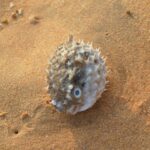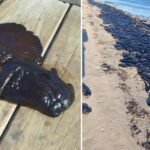Does your dog love the beach?
November 6, 2023
A Day at the Beach
Did you know 70 percent of Australians live within 30 kilometers of a beach. As travellers we also love our amazing beaches and the diversity this country offers, from the turquoise waters off North Western Australia, to the deep blue waters in the southern Ocean, to the spectacular east coast surf beaches and the Great Barrier Reef in North Queensland, Australia is a land girt by sea. Beaches are one of our favourite places, and many of our dogs also love them.
They get to swim, walk, play, chase balls, surf, perhaps even swim with dolphins and spend quality time with their hoomans. However it is important to be vigilant when you take your dog to the beach because there are a number of potential dangers that you should be aware of including:
Heatstroke – On a hot day, your dog may suffer from heatstroke because the sand will burn their paws and reflect additional heat. If you are staying on the beach for a bit and maybe relaxing, or maybe doing strenuous exercise, be sure to bring some shelter/shade for your dog and plenty of fresh water. You may want to consider bringing booties to protect their paws from heat as well as rocks and sharp objects like broken shells, which can also cause painful cuts to their paws.
Sunburn – Dogs also get sunburned, so make sure you bring pet-safe sunscreen for areas with thin fur or exposed skin, such as the nose and ears. Don’t forget to check the temperature of the water too – if it is too hot for your dog, they should be kept away from it – especially in northern parts of Australia on hot summer days. You should also bring a towel to dry them off after their time at the beach.
Sand ingestion – if more than a little, can cause serious bowel impactions -so, if playing ball with your dog, make sure your dog doesn’t get too much sand in their mouth – keep the ball dry as much as possible, so that not too much sand sticks to it. Don’t throw sticks, as they can hold more sand in crevices and if running can cause injury from sharp ends.
Salt water ingestion – if only a few mouthfuls, your dog may get diarrhoea, but drinking a large amount of sea water can be fatal. When a dog ingests salt water, the excess salt draws water from the blood into the intestines, leading to diarrhea, vomiting, and dehydration. Don’t let your dog drink from the sea.
Dangerous sea creatures that often wash ashore, such as:
 Puffer fish – highly toxic puffer fish can wash ashore and are a curiosity to our dogs. They contain the substance tetrodotoxin, one of the most lethal natural substances. A puffer fish contains enough tetrodotoxin to kill 30 people. Do not let your dog near them as even licking or biting them can cause a serious case of poisoning. Symptoms can progress quickly from vomiting, drooling and lethargy to muscle tremors, seizures, trembling and dilated pupils then paralysis and coma. It is important to get your dog to a vet immediately if you think your dog has ingested any puffer fish toxin.
Puffer fish – highly toxic puffer fish can wash ashore and are a curiosity to our dogs. They contain the substance tetrodotoxin, one of the most lethal natural substances. A puffer fish contains enough tetrodotoxin to kill 30 people. Do not let your dog near them as even licking or biting them can cause a serious case of poisoning. Symptoms can progress quickly from vomiting, drooling and lethargy to muscle tremors, seizures, trembling and dilated pupils then paralysis and coma. It is important to get your dog to a vet immediately if you think your dog has ingested any puffer fish toxin.
Photo by Abhilash Balakrishnan on Unsplash
 Sea slugs (aka Sea hares) – Sea Slugs secrete a toxic dye and slime but also can have a toxic slime layer over their bodies, so even licking a spot where a sea slug was can be dangerous. Once a dog licks or picks up a Sea Slug, they can ingest the dye or slime. This can cause spasms and other serious reactions. If your dog has eaten a sea slug, contact a veterinarian immediately.
Sea slugs (aka Sea hares) – Sea Slugs secrete a toxic dye and slime but also can have a toxic slime layer over their bodies, so even licking a spot where a sea slug was can be dangerous. Once a dog licks or picks up a Sea Slug, they can ingest the dye or slime. This can cause spasms and other serious reactions. If your dog has eaten a sea slug, contact a veterinarian immediately.
Always take your dog to dedicated dog beaches.
 There are also many species of wildlife on the beach, such as crabs, fish, and other marine animals in shallow rock pools, and many bird species as well – some species of birds such as shorebirds are dependent upon this habitat for survival. Non-migratory species like these pied Oystercathers (photo inset) nest in the dunes and feed and roost along the shoreline. Protecting them is important for the ecological balance of our beaches.
There are also many species of wildlife on the beach, such as crabs, fish, and other marine animals in shallow rock pools, and many bird species as well – some species of birds such as shorebirds are dependent upon this habitat for survival. Non-migratory species like these pied Oystercathers (photo inset) nest in the dunes and feed and roost along the shoreline. Protecting them is important for the ecological balance of our beaches.
Each spring many migratory shorebird species travel thousands of kilometres from their breeding grounds in the Arctic to feed and rest here. When people and dogs regularly disturb them, they may not be able to build enough energy reserves to return to their northern breeding grounds.
Please obey the rules and regulations, keep your pets away from dog-prohibited beaches, leash them on leash-only beaches, walk your pets on the wet sand and never let them chase birds or other wildlife.
Off leash dog beaches are the only places you should let your dogs run free, but they should also be controlled, and you need to be vigilant of potential dangers. Above all, enjoy your time with your bestie.


